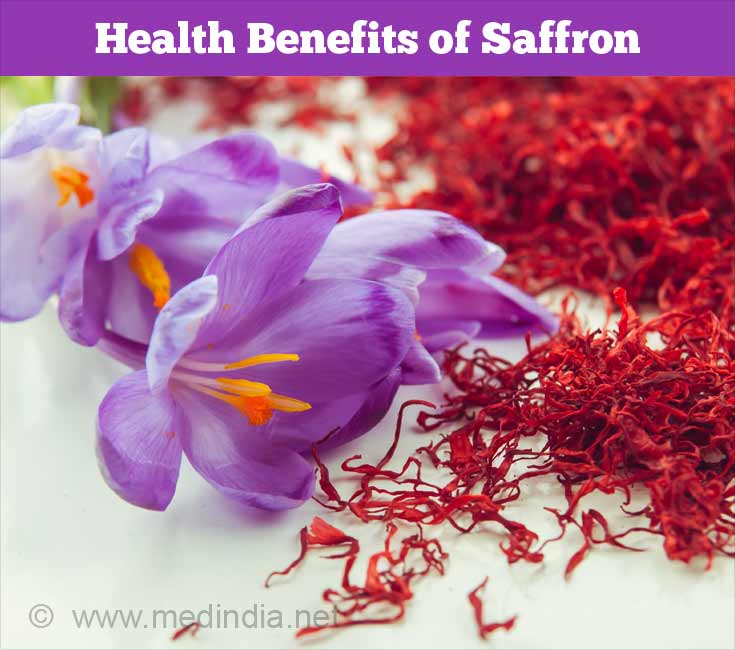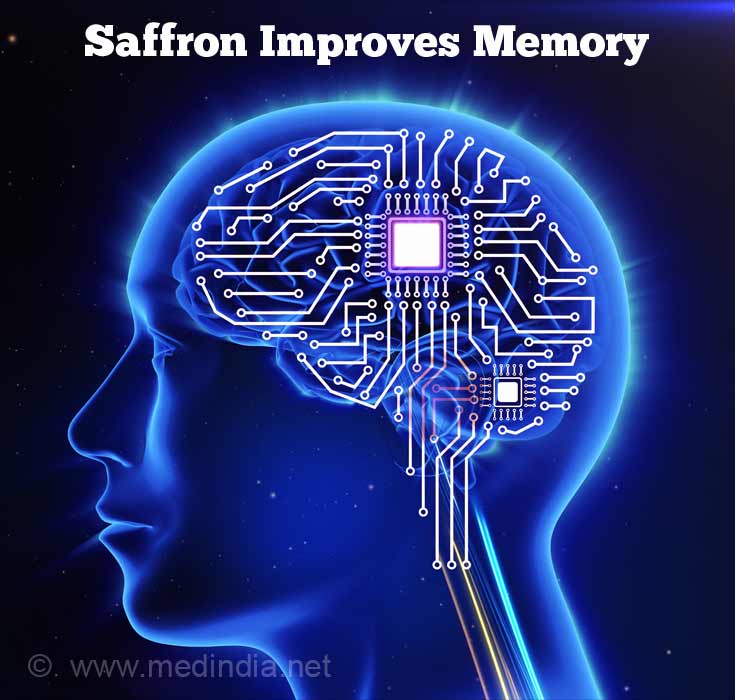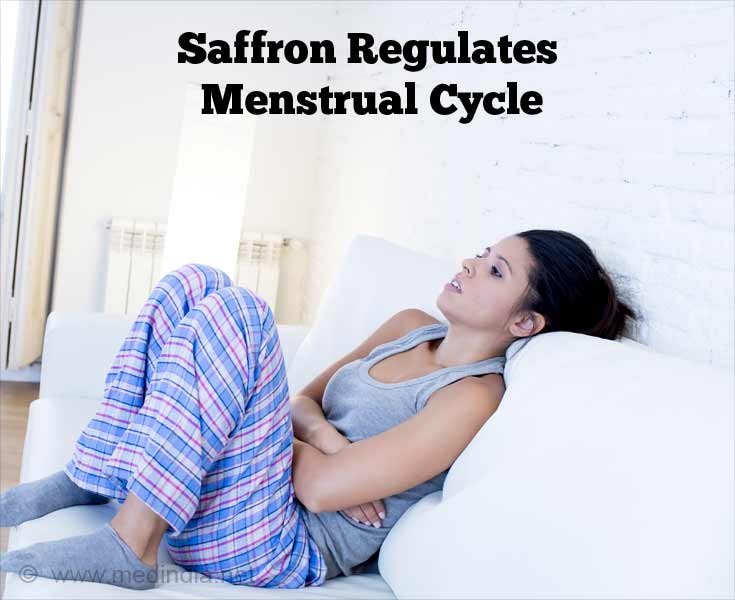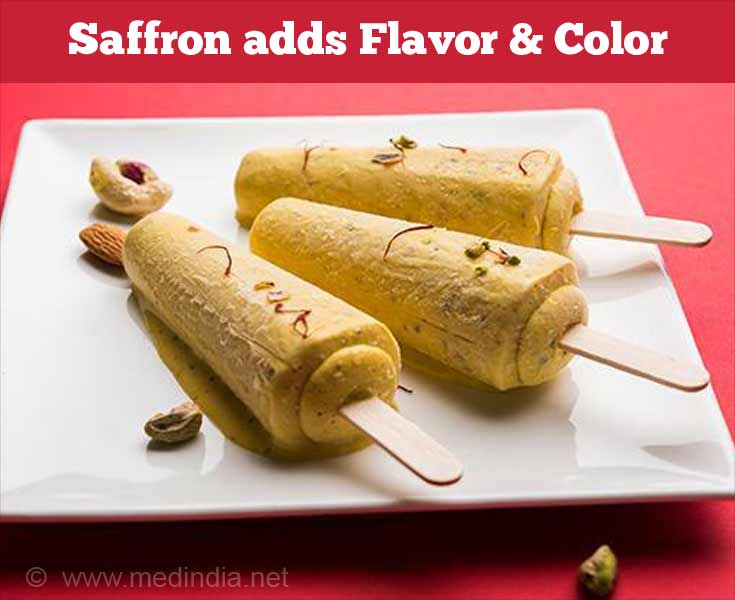- MEDICINAL USES AND PHARMACOLOGICAL PROPERTIES OF CROCUS SATIVUS LINN(SAFFRON) - (https://innovareacademics.in/journal/ijpps/vol3suppl3/2186.pdf)
- Therapeutic properties of saffron and its chemical constituents - (http://www.journalofnaturalproducts.com/volume7/2_res_paper-1.pdf)
What is Saffron?
Saffron, the stigma of the flowering plant Crocus sativus Linn (Iridaceae) is used widely in tropical and subtropical countries for a variety of household and medicinal purposes. The word "saffron" is derived from the Arabic word za'faran, which translates to "yellow." The unique color, flavor and other properties of saffron give it the culinary and medicinal characteristics that make it renowned all over the world.
Saffron contains more than 150 volatile and aroma-yielding compounds. The strong odor of saffron is due to the 40-50 volatile components present in it. Also, saffron has many non-volatile constituents such as carotenoids, zeaxanthin, alpha, beta and gamma-carotenes and lycopene. Certain characteristic components of saffron give saffron its trademark color, taste and odor. They are crocin – responsible of the color, picrocrocin – responsible of the bitter taste, and safranal – responsible odor and aroma.

Health Benefits of Saffron
Potential healing properties of saffron and its constituents are prominent against cancer, depression, anxiety, erectile dysfunction, diabetes, heart disease, ulcer and it improves learning and memory skills. In addition to Crocin and picrocrocin, other chemical compounds like anthocyanins, flavonoids, vitamins (riboflavin and thiamine), amino acids, proteins, starch, mineral matter, gums have been found in saffron.
- Skin Benefits:Saffron is used in face packs to lighten skin tone. Wash your face and wipe with a clean dry cloth. Prepare a facial with 1 teaspoon of sandalwood powder, 2 to 3 strands of saffron and 2 spoons of milk. Apply as a face mask and wash after 20 minutes. You can also soak sunflower seeds in water and saffron in milk and grind it as a paste for a face mask.
- Anticancer Activity: Saffron is a rich source of carotenoids and is known to have anticancer and antitumor properties. It inhibits the growth of tumor cells. Various research findings show the positive relationships between carotenoids present in saffron and its inhibitory effect on the growth of DNA synthesis. The anti proliferative properties of saffron extract and crocin were reported against human prostate cancer and human leukemia HL-60 cells. Research concluded that crocin inhibited the respective cell proliferation, arrested cell cycle progression, and induced apoptosis in a time and concentration-dependent manner.
- Improves Memory: Saffron is shown to inhibit the aggregation and deposition of protein molecules, which clump in the brain causing Alzheimer’s. Anti-oxidant activity of saffron extract and crocin have prevented spatial learning and memory impairment caused by the effect of chronic-induced stress.

- Antidiabetic Activity: Saffron significantly increased serum insulin and lowered blood glucose levels. Saffron methanolic extract, when given to rats, significantly reduced the fasting blood glucose and HbA1c levels. They also increased the blood insulin levels without affecting the renal and liver functions. Crocin and safranal, the antioxidants present in the extract were the reason for the hypoglycemic effect.
- Anti-Depressant: The activity of saffron extract was shown to be equivalent to that of fluoxetine and impramine, drugs used for depression. The effective curative property in the treatment of mild to moderate depression is mainly due to the extract of dried petal of saffron plant.
- Eases Menstrual Pain: In traditional medicine, the herb of saffron plant is used for promoting and regulating menstrual periods. It also reduces lumbar pains that accompany menstruation. Saffron is also beneficial in treating leucorrhea, the condition where estrogen imbalance causes a whitish yellow discharge during menstruation.

- Reduces Lipid Levels: Crocin, present in saffron has shown to have a lipid lowering effect in various animal studies. Crocin inhibited the absorption of dietary fat and cholesterol, and increased excretion of fat in the feces. Also, the effect of a key enzyme, pancreatic lipase, is inhibited by the action of crocin, enabling the hypolipidemic effect.
How to use Saffron?
Commercially, saffron is available as dried strands or as powder. Take few dried strands of saffron and soak in about 2 to 3 teaspoons of hot water or warm milk. The color of the strand leaches into the water in a few hours depending on the quality of the saffron. For better results, you can soak the saffron overnight and use just a few drops of the water in your dish.
Cooking with Saffron
Saffron is used for flavor, color and to enhance the aroma of a dish. It is more of a flavoring ingredient than a main ingredient. Saffron is used in various cuisines all around the world. In some regions, it marks a traditional dish.
- In India, saffron is used as a flavoring ingredient in many recipes of rice, sweets, and ice-creams.

- A real Arabic coffee is never complete without saffron and cardamom.
- North of Italy uses saffron as an essential part in the preparation of Risotto.
- The traditional bread prepared in Sweden on the day of St. Lucile contains saffron.
Seafood dishes such as bouillabaisse and paella, risotto and other rice dishes are never complete without saffron. Any tomato based sauce, beef stew tastes delicious with the magic of saffron.
Add saffron threads, garlic, and thyme to vinegar to make a wonderful marinade for fish. Saffron is also used in bread and cake cooking.






